![]()
![]()
![]()
Use LEFT and RIGHT arrow keys to navigate between flashcards;
Use UP and DOWN arrow keys to flip the card;
H to show hint;
A reads text to speech;
17 Cards in this Set
- Front
- Back

|
King Djoser Serdab Statue from step pyramid complex Saqqara Dynasty 3 Royal Sculpture
- Ka statue - first life size statue of a king - limestone statue - originally covered in paint - in throne position, wearing heb seb festival robe - frontal art --> only viewed from the front - large eyes, originally filled with rocks - nemes headdress is worn instead of a crown |
|

|
Khafre seated, from Khafre's Valley Temple Giza Dynasty 4 Royal Sculpture
- made of stone quarried from Nubia (shows trade) - Frontal statue but it has a more intricate back with Horus wings wrapping around - 24 statues found in Valley temple for each hour of the day - detailed carvings - Khafre wearing a kilt and not heb seb robe to show a new ideal of the body, skinny inward torso - lotus and papyrus intertwining on the throne to symbolized king of upper and lower egypt |
|
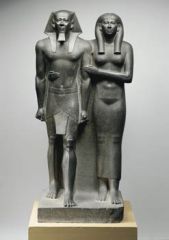
|
Menkaure and Queen Khamerernebty Giza Dynasty 4 Royal Sculpture
- statue with queen - not lifesize - made of slate - unfinished statue because he died early - striding pose --> action pose (all pressure is on the back leg showing no real movement) - 1st depiction of a king and queen together (queen mimics the kings pose) - King and Queen Shown pretty equal, but queen is a little less in everything - Queen is supporting king
|
|
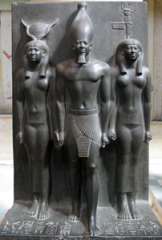
|
Triad statue of Menkaure, Hathor and Hare nome goddess Giza Dynasty 4 Royal Sculpture
- found in Menkaure's valley temple - earliest depiction of King with God - Hathor: Cow goddess, protector of the king - nome goddess shows the control he had and those resources will provide for him in the afterlife - Wearing upper Egypt crown - striding pose |
|

|
Seated Statue of Ankhwa Dynasty 3 Private Sculpture
- mimic the pose of the king - cannon of proportions is less strict - found in his tomb - made of red granite - holding a tool to show his specialty (woodworking skills- possibly a ship builder) - wears a wig - body is more blocky |
|
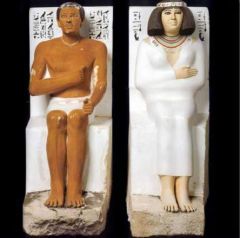
|
Rahotep and Neferet Tomb chapel Meidum Dynasty 4 Private Sculpture
- Rahotep was a high up government official - Title ' "physical son of the King" --> he could be the son of the king or just a title - Nefert was "known by the king" - Rahotep was the high priest of the cult of Ra in Heliopolis - Ka Statues (separate for each person) - first statue with paint preserved - made of limestone and plastered over and painted - eyes inlaid with rock crystals - men and women depicted as equals - Rahotep mimics the dress of the king - skin color represents gender not social class |
|
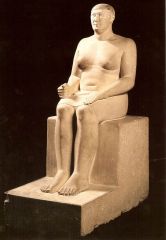
|
Prince Hemon Giza Dynasty 4 Private Sculpture
- Member of the royal family --> grandson of King Sneferu - Served as Vizier of Khufu - Oversaw all construction during Khufu's time, may have been the architect of the Great Pyramid - Very large mastaba close to pyramid - Ka statue of Hemon - heavier depiction of Hemon showing that he can be overweight because he has high status and lots to eat - may not have been that large, but shows an ideal |
|

|
Reserve Heads Giza Dynasty 4 Private Sculpture
- Only found in Dynasty 4 in Giza - found in elite mastabas of people related to the king - placed in the burial chamber next to the body - attempting to capture the essence of the people - all bald --> do not know gender - explanations: rituals or models for other statues
|
|
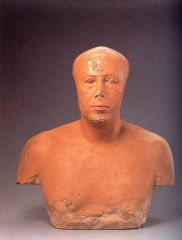
|
Ankh-haf Dynasty 4 Giza Private Sculpture
- served as vizier to Khafre - buried close to Khafre's pyramid - made of limestone - more individuality in face |
|
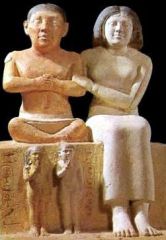
|
Dwarf Seneb and family Giza Dynasty 4 Private Sculpture
- Dwarfs were very well respected - Seneb was the royal tutor for the children - dwarfs were either gold workers or tutors - husband and wife on same block - children placed where Senebs legs should be - scroll on Senebs lap showing his job - first time seeing children depicted - children always shown naked and distinct hair (shaved head with pony tail), finger to mouth is a sign of childhood - limstone covered in plaster |
|
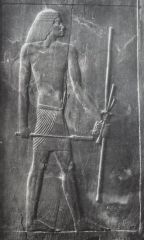
|
Tomb of Hesira Portrait panels (standing relief) Saqqara Dynasty 3
- 11 niches inside mastaba with reliefs - formal portraits showing him in each position he held - carved out of wood - Hesira is standing , rigid like a king, mixed composite view, striding pose, wearing a wig and mustache - Naturalism: detail of the muscle - carrying symbols of office - wood from acacia tree --> symbolizes eternity - cannon of proportions |
|
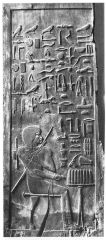
|
Tomb of Hesira Portrait panels (seated relief) Saqqara Dynasty 3
- looks aged -wears different style wig - making offerings - above him are heiroglyphs that list offerings |
|

|
Tomb of Khabausokar relief Saqqara Dynasty 3
- walls covered with reliefs - displays list of offerings and prayers and reliefs of his jobs - image and words go together - depicted in the cannon of proportions |
|
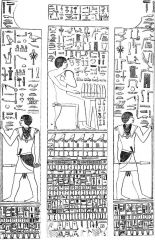
|
Tomb of Khabausokar relief Saqqara Dynasty 3 |
|
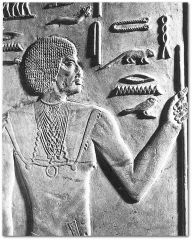
|
Tomb of Khabausokar relief Saqqara Dynasty 3 |
|

|
Painted Stela of Princess Nofretyabet Giza Dynasty 3
- slab that would decorate her tomb - sitting at the offering table - wearing a leapard dress showing trade - longer wig style |
|
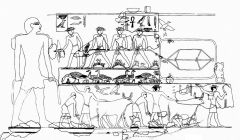
|
Tomb of Itet Meidum Dynasty 4
- Found close to King sneferu's pyramid - painting shows scenes of men capturing geese - animals are very realistic and detailed |

